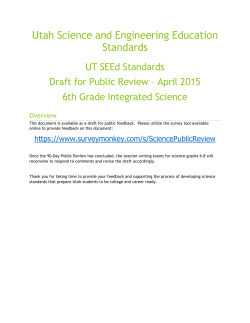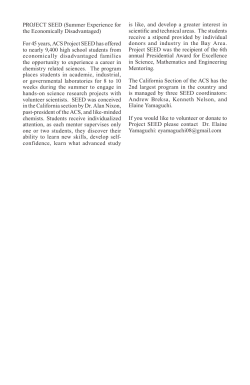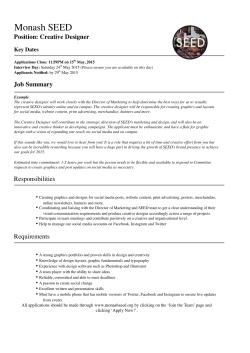
7th Grade
Utah Science and Engineering Education Standards UT SEEd Standards Draft for Public Review – April 2015 7th Grade Integrated Science Overview This document is available as a draft for public feedback. Please utilize the survey tool available online to provide feedback on this document: https://www.surveymonkey.com/s/SciencePublicReview Once the 90-Day Public Review has concluded, the teacher writing teams for science grades 6-8 will reconvene to respond to comments and revise the draft accordingly. Thank you for taking time to provide your feedback and supporting the process of developing science standards that prepare Utah students to be college and career ready. Utah Science & Engineering Education Standards Seventh Grade Overview AF T The Utah Science & Engineering Education (UT SEEd) Standards will enable students to use multiple science practices and concepts to understand mechanisms and systems. In Seventh Grade the concepts of patterns across a wide array of scales give students the opportunity to understand cause and effect mechanisms in physical, life, and earth sciences. Performance expectations1 are written in such a way as to require students to ask authentic questions and analyze real-world evidence. These practices and experiences will enable learners to have opportunities to arrive at and communicate informed arguments. Combining authentic scientific practice and crosscutting concepts across a diversity of disciplinary core ideas gives students the opportunity to cultivate ideas that will be built upon in upper grades and beyond. In the Seventh Grade, students will consider many sources of data that are not immediately obvious. These include changes that occur over vast amounts of time, such as biological evolution and processes of our planet, so connections between how we understand natural selection, the fossil record, and Earth’s dynamics can be made. Students engage in motion and systems at the most hands-on and the grandest levels as they consider force and motions that range from small electrical charges to massive planetary systems. In all cases, students analyze data to craft explanations and models that highlight the cause and effect mechanisms in multiple scientific disciplines. 3 Dimensions of Science 2 Instruction in UT SEEd Standards Bold = 7th Grade Focus Scientific and Engineering Practices 1. Patterns 2. Cause and effect: Mechanism and explanation 3. Scale, proportion and quantity 4. Systems and system models 5. Energy and matter: Flows, cycles and conservation 6. Structure and function 7. Stability and change D R 1. Asking questions or defining problems 2. Developing and using models 3. Planning and carrying out investigations 4. Analyzing and interpreting data 5. Using mathematics and computational thinking 6. Constructing explanations and designing solutions 7. Engaging in argument from evidence 8. Obtaining, evaluating, and communicating information Crosscutting Concepts Disciplinary Core Ideas Physical: matter, motion, energy, waves Life: molecules to organisms, ecosystems, heredity, biological evolution Earth: Earth’s place in the universe, Earth’s systems, Earth and human activities Engineering: Design, links among engineering, tech, science and society Next Generation Science Standards: http://www.nextgenscience.org NRC Framework K-12 Science Education: http://www.nap.edu/catalog.php?record_id=13165 UT SEEd Standards DRAFT (4.9.2015) 1 2 7th Grade Grade Level Themes/Questions (7th Grade) Root Question 1: How does the structure and behaviors of an organism affect its ability to grow, survive, and reproduce? PERFORMANCE EXPECTATIONS: 7.1.1: Use argument based on empirical evidence and scientific reasoning to support an explanation for how characteristic animal behaviors and specialized plant structures affect the probability of successful reproduction of animals and plants respectively. 7.1.2: Conduct an investigation to provide evidence that living things are made of cells; either one cell or many different numbers and types of cells. 7.1.3: Construct a scientific explanation based on evidence for how environmental and genetic factors influence the growth of organisms. 7.1.4: Develop and use a model to describe why structural changes to genes (mutations) located on chromosomes may affect proteins and may result in harmful, beneficial, or neutral effects to the structure and function of the organism. 7.1.5: Develop and use a model to describe why asexual reproduction results in offspring with identical genetic information and sexual reproduction results in offspring with genetic variation. 7.1.6: Construct an explanation based on evidence that describes how genetic variations of traits in a population increase some individuals’ probability of surviving and reproducing in a specific environment. 7.1.7: Gather and synthesize information about the technologies that have changed the way humans influence the inheritance of desired traits in organisms. AF T Root Question 2: What patterns can be observed as evidence to support changes in species over time? PERFORMANCE EXPECTATIONS: 7.2.1: Analyze and interpret data for patterns in the fossil record that document the existence, diversity, extinction, and change of life forms throughout the history of life on Earth under the assumption that natural laws operate today as in the past. 7.2.2: Analyze displays of pictorial data to compare patterns of similarities in the embryological development across multiple species to identify relationships not evident in the fully formed anatomy. 7.2.3: Use mathematical representations to support explanations of how natural selection may lead to increases and decreases of specific traits in populations over time. 7.2.4: Apply scientific ideas to construct an explanation for the anatomical similarities and differences among modern organisms and between modern and fossil organisms to infer evolutionary relationships. Root Question 3: How does the cycling of matter and energy affect Earth’s evolution over time? PERFORMANCE EXPECTATIONS: 7.3.1: Construct a scientific explanation based on evidence from rock strata for how the geologic time scale is used to organize Earth’s 4.6-billion-year-old history. 7.3.2: Develop a model to describe the cycling of Earth’s materials and the flow of energy that drives this process. 7.3.3: Construct an explanation based on evidence for how processes have changed Earth’s surface at varying time and spatial scales. 7.3.4: Analyze and interpret data on the distribution of fossils and rocks, continental shapes, and seafloor structures to provide evidence of plate motions. R Root Question 4: How does gravity influence the structure, organization, and motion of objects in space? PERFORMANCE EXPECTATIONS: D 7.4.1: Develop and use a model of the Earth-sun-moon system to describe the cyclic patterns of lunar phases, eclipses of the sun and moon, and seasons. 7.4.2: Evaluate competing design solutions using a systematic process to determine how well they meet the criteria and constraints of the problem. 7.4.3: Define the criteria and constraints of a design problem with sufficient precision to ensure a successful solution, taking into account relevant scientific principles and potential impacts on people and the natural environment that may limit possible solutions. 7.4.4: Develop and use a model to describe the role of gravity in the motions within galaxies and the solar system. 7.4.5: Analyze and interpret data to determine scale properties of objects in the solar system. Root Question 5: How do forces interact with matter? PERFORMANCE EXPECTATIONS: 7.5.1: Apply Newton’s Third Law to design a solution to a problem involving the motion of two colliding objects. 7.5.2: Develop a model to generate data for iterative testing and modification of a proposed object, tool, or process such that an optimal design can be achieved. 7.5.3: Plan an investigation to provide evidence that the change in an object’s motion depends on the sum of the forces on the object and the mass of the object. 7.5.4: Ask questions about data to determine the factors that affect the strength of electric and magnetic forces. 7.5.5: Analyze data from tests to determine similarities and differences among several design solutions to identify the best characteristics of each that can be combined into a new solution to better meet the criteria for success. 7.5.6: Construct and present arguments using evidence to support the claim that gravitational interactions are attractive and depend on the masses of interacting objects. 7.5.7: Conduct an investigation and evaluate the experimental design to provide evidence that fields exist between objects exerting forces on each other even though the objects are not in contact UT SEEd Standards DRAFT (4.9.2015) 7th Grade
© Copyright 2025














